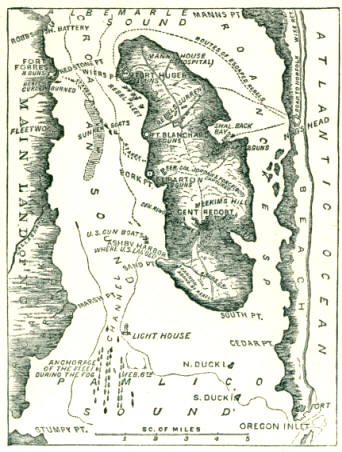Roanoke Island
|
|
This Site:
|
In the American Civil War Roanoke Island became historically conspicuous, Early in 1862 an expedition was fitted out at Hampton Roads for operations against the island. It was composed of over 100 war-vessels and transports, commanded by Commodore L. M. Goldsborough, and bearing 16,000 troops under General Ambrose E. Burnside. The armament left the Roads on Sunday, Jan. 11, 1862, with its destination unknown excepting to certain officers. The land force was divided into three brigades, commanded respectively by Gens. J. G. Foster, J. L. Reno, and J. G. Parke. The fleet was divided into two columns for action, intrusted respectively to the care of Commanders S. F. Hazard and S. C. Rowan. Its destination was Pamlico Sound, through Hatteras Inlet, and its chief object was the capture of Roanoke Island, which the Confederates had strongly fortified with batteries which commanded the sounds on each side of it. There was also a fortified camp that extended across a narrow part of the island. These fortifications were garrisoned by North Carolina troops under Col. H. M. Shaw, and mounted forty guns. Above the island, in Croatan Sound, was a Confederate flotilla of small gunboats, commanded by Lieut. W. F. Lynch, formerly of the United States navy. Goldsborough drew up his fleet in Croatan Sound and opened a bombardment (Feb. 7) upon the works on the island. Four of his transports, one gunboat, and a floating battery had been smitten by a storm off Hatteras before entering the still waters of the inlet and wrecked. Goldsborough had moved his gunboats towards the island to open fire in columns, the first being led by the Stars and Stripes, Lieut. Reed Werden ; the second by the Louisiana, Commander A, Murray; and the third by the Hetzel, Lieut. H. R. Davenport. The Southfield was the flag-ship. The first attack was upon Fort Bartow, on Pork Point, towards the northern end of the island, and in twenty-one minutes a general engagement took place between the gunboats and the batteries in Croatan Sound, in which the little flotilla participated. These vessels disposed of, Goldsborough concentrated his fire on Fort Bartow, three-fourths of a mile distant. Burnside's headquarters were on the S. R. Spaulding. As Fort Bartow began to give way the transports were brought up, and at midnight, while a cold storm of wind and rain was sweeping over land and water, about 11,000 troops were landed, many of them wading ashore. These were New England, New York, and New Jersey troops. They were without shelter. At dawn, led by General Foster, they moved to attack the line of entrenchments that spanned the island. The Confederates, much inferior in numbers, made a gallant defense, going from redoubt to redoubt as one after another fell into the hands of the Nationals. They made a vigorous stand in a well-situated redoubt that was approached by a causeway. There was to be the last struggle in defense of the line. At the head of Hawkins's Zouaves, Major Kimball, a veteran of the war with Mexico, undertook to take it by storm. Colonel Hawkins was then leading a flank movement with a part of his command. Seeing the major pushing forward, the colonel joined him, when the whole battalion shouted, "Zou ! Zou! Zou!" and pressed to the redoubt. The Confederates fled and were pursued about 6 miles, when they surrendered, and Roanoke Island passed into the possession of the National forces. The Confederate flotilla fled up Albemarle Sound, pursued by National gun-boats under Commander Rowan. Near Elizabeth, not far from the Dismal Swamp, Rowan attacked the flotilla and some land batteries, driving the Confederates from both, while Lynch and his followers retired into the interior. Then the United States flag was placed upon a shore-battery, and this was the first portion of the North Carolina main that was repossessed by the government. The loss of Roanoke Island was a severe one for the Confederates. The National loss in the capture of the island was about 50 killed and 222 wounded; that of the Confederates was 23 killed, 58 wounded, and 62 missing. |
|
|
||
|
|
Site Copyright 2003-2018 Son of the South. For Questions or comments about this collection, contact: paul@sonofthesouth.net |
|
|
Are you Scared and Confused? Read My Snake Story, a story of hope and encouragement, to help you face your fears. |
||
 Roanoke
Island was discovered by Amidas and Barlow in July, 1584,
and taken possession of in the name of Queen Elizabeth. These
navigators spent several weeks in explorations of that island and
Pamlico and Albemarle sounds, and in trafficking with the natives.
"The people," wrote the mariners, "were most gentle, loving, and
faithful, void of all guile and treason, and such as lived after the
manner of the Golden Age." They were hospitably entertained by the
mother of Wingina, King of Roanoke, who was absent. When they left
they took with them Manteo and Wanchese, two dusky lords of the
woods from the neighboring main.
Roanoke
Island was discovered by Amidas and Barlow in July, 1584,
and taken possession of in the name of Queen Elizabeth. These
navigators spent several weeks in explorations of that island and
Pamlico and Albemarle sounds, and in trafficking with the natives.
"The people," wrote the mariners, "were most gentle, loving, and
faithful, void of all guile and treason, and such as lived after the
manner of the Golden Age." They were hospitably entertained by the
mother of Wingina, King of Roanoke, who was absent. When they left
they took with them Manteo and Wanchese, two dusky lords of the
woods from the neighboring main.